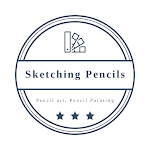Sketching pencils are essential tools for artists, whether you're a beginner or an experienced professional. The right set of sketching pencils can make a significant difference in the quality and outcome of your artwork. However, with so many options available on the market, choosing the best sketching pencils can be overwhelming. This buyer's guide aims to simplify the process and help you unleash your artistic potential by providing essential factors to consider when selecting sketching pencils.
 |
| The Ultimate Buyer's Guide to Choosing the Best Sketching Pencils |
1. Graphite Grades:
Graphite grades determine the darkness or lightness of the marks you make. Pencils are usually labeled with a combination of numbers and letters to indicate their hardness or softness. The most common grading scale ranges from 9H (hardest) to 9B (softest). The higher the H number, the harder the lead, while the higher the B number, the softer and darker the lead. A set of pencils with a variety of grades (e.g., 2H, HB, 2B, 4B, 6B) provides versatility for different sketching techniques.
2. Lead Quality:
The quality of the lead significantly impacts your drawing experience. Look for sketching pencils with high-quality graphite leads that are smooth, break-resistant, and capable of producing consistent lines. Avoid pencils with leads that are prone to smudging or crumbling as they can negatively affect your artwork.
3. Wooden vs. Mechanical Pencils:
Sketching pencils come in two primary forms: wooden and mechanical. Wooden pencils are traditional and offer a comfortable grip, allowing for greater control and shading capabilities. They are available in various shapes and sizes. Mechanical pencils, on the other hand, feature a retractable lead mechanism, eliminating the need for sharpening. They are more convenient, produce consistent lines, and are ideal for detailed work.
4. Comfort and Grip:
Consider the comfort and grip of the pencils you choose, as you'll be holding them for extended periods. Look for pencils with ergonomic designs or rubberized grips that provide a secure and comfortable hold. Comfortable pencils enable you to focus on your art without causing strain or fatigue.
5. Additional Accessories:
Some sketching pencil sets include additional accessories that can enhance your artistic process. These accessories may include erasers, sharpeners, smudging tools, blending stumps, and more. Having these extra tools readily available can be convenient and save you from purchasing them separately.
6. Brand and Price:
Consider reputable brands that specialize in art supplies. They often provide consistent quality and reliable performance. While price shouldn't be the sole determining factor, it's important to set a budget. Higher-priced sketching pencils may offer superior quality and durability, but there are also affordable options available that can deliver satisfactory results.
7. Personal Preference and Experimentation:
Ultimately, choosing the best sketching pencils is subjective. What works for one artist may not work for another. Consider your personal preferences, sketching style, and the techniques you use. Don't be afraid to experiment with different brands and pencil types to find the ones that suit your artistic needs.
Conclusion:
Selecting the best sketching pencils involves considering factors such as graphite grades, lead quality, pencil type, comfort, additional accessories, brand reputation, and personal preference. By carefully assessing these factors and experimenting with different options, you can find the perfect set of sketching pencils that will unleash your artistic potential and help you create stunning artwork. Remember, the right tools can make all the difference in your artistic journey.

%20(1)%20(1).jpg)

%20(1)%20(1).jpg)
Post a Comment
0 Comments